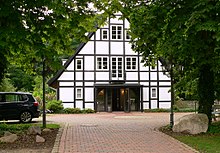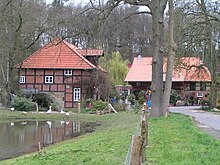Heiligenberg Monastery

Kloster Holy Mountain is a former Premonstratensian - pin from the 13th century in Lower Saxony spots Bruchhausen-Vilsen in Diepholz . It was located within a ring wall system , the walls of which have largely been preserved.
history
The Premonstratensian Abbey in Heiligenberg, known colloquially today as “monastery”, was first documented in 1223, but the divisionists, which were run in various Premonstratensian branches at the same time, prove that the order took possession of the location in the Archdiocese of Bremen in 1218 . Archbishop Gerhard I of Bremen, who died in 1219, added the parish church to Vilsen to the foundation through six count brothers from Wernigerode. The monastery was dedicated to the Virgin Mary and Saint Thomas of Canterbury. The veneration of the English martyr Thomas Becket points to close ties to the Welfenhaus, represented at that time by Emperor Otto IV and Count Palatine Heinrich. Archaeological research has shown that the site, previously known as Heiligenberg , served as an aristocratic residence from the 9th to the 12th centuries. In 1217/1218 Gervasius, abbot of the Order of Canons from the Prémontré Primary Abbey, wrote a letter to Pope Honorius III. and asked him for protection for the abbey to be founded. This letter, which was wrongly suspected of being a forgery, names a Count C. or G. von Wernigerode in front of his five brothers as responsible. The best manuscript tradition prefers the initial C . Based on the latest state historical research, it can be considered certain that it was the eldest of the six count brothers, Konrad I. The monastery existed until 1543.
Initially, Bishop Adolf von Osnabrück from the house of the Counts of Tecklenburg exercised the office of spiritual protector . Secular patrons, perhaps since the fourth decade of the 13th century, were the Counts of Oldenburg-Bruchhausen, on whose territory the monastery was located. After the acquisition of the Grafschaft Bruchhausen by the Counts of Hoya , the Bailiwick office was transferred to them. The founding of the Heiligenthal Abbey near Kirchgellersen and (later) in Lüneburg came from Heiligenberg. After the Reformation , the Premonstratensian convent dissolved in 1535. The handful of canons who had accepted the Reformation remained until the final secularization in 1543 by Count Jobst II of Hoya or took over offices as Lutheran pastors or sextons. The Verden historian Hartmut Bösche published the previously unedited library catalog of the Heiligenberg Canons from 1539. It contains 129 titles, which are now available in detail. Bösche also succeeded in locating a late Gothic chalice from the inventory of the monastery, which is now in the Evangelical Lutheran parish church of Asendorf, district of Diepholz.
The local researcher Heinrich Bomhoff (died 2014) also discovered a reliquary box with Thomas Becket representations in the former Premonstratensian Abbey Church in Clarholz, which probably got there via the Tecklenburg counts from Heiligenberg.
In 1563 the church had already fallen into ruin. In the period 1563-1620 the farm buildings and the estate belonged as Vorwerk for Bruchhauser widow seat of the last Countess of Hoya. This used the abandoned church buildings as a quarry to build their castle in Bruchhausen. The last parts of the monastery buildings were demolished in 1607. In the second half of the 17th century, the dukes of Braunschweig-Lüneburg zu Celle used the Bruchhauser Castle as a summer residence ; from there they went to hunt herons on the Heiligenberg. In 1794 the Vorwerk building was converted into the official residence of the riding forester; the forester's house received a liquor license . In 1962 it was sold by the Syke Forestry Office and in 1966 the “Forsthaus Heiligenberg” restaurant was opened. This was expanded into a hotel and conference center in 2001, with the creation of a rose and herb garden .
In 2018, an 800th anniversary of the monastery was planned. The archaeologist Friedrich-Wilhelm Wulf planned to hold a symposium with the historian Sönke Thalmann on the Heiligenberg on the subject of "The Premonstratensians in Northern Germany".
Ring wall
The ring wall system at Heiligenberg has a diameter of up to 240 meters with an area of 2.5 hectares . The length of the wall was originally 465 meters. For the construction of the fortifications, steep slopes were used, for the most part, along two confluent streams, on which a small wall was raised. A new rampart with a height of up to 8.40 meters with a ramp was built up for only a quarter of the circular rampart. It is assumed that the ring wall dates from prehistoric times and was used as a refuge in the Middle Ages .
Archaeological research
The first archaeological investigation of the area within the ramparts took place before the hotel's guest house was built in autumn 2011 on an area of almost 1000 m². Around 100 archaeological findings in the form of post holes and garbage pits were found and ceramic fragments were found as traces of settlement from the 9th century. The findings suggest a 13 × 15 meter building with a tiled roof, which could have been a church belonging to the Premonstratensian monastery.
The investigations confirmed the assessment of various historians that Heiligenberg was a manorial seat built in the early Middle Ages before the foundation of the Premonstratensian monastery , which, with the main castle, inner and outer outer bailey, took up more than seven hectares.
In winter 2012/2013 a geophysical prospecting and an airborne laser scanning of around 4 km² was carried out. Rectangular structures were found in the ground that suggest earlier buildings.
In 2013, Vechta mediaevalist Bernd Ulrich Hucker became aware of a presumably prehistoric spring, the so-called Paterborn , in the valley north of the former abbey. Then the sandstone setting of the spring was exposed by the restaurant and hotel "Forsthaus Heiligenberg".
2014 took Lower Saxony Conservation Office on 17 meters long and 4 meters wide a dig-section through the outer silicone matrix of the fore-castle before. The 1.8 meter high wall consists of fine sandy silt under a 10 cm thick humus top soil . There were no indications of fixtures in the embankment, but there were individual ceramic shards and iron fragments in it. The embankment was protected by an upstream two meter deep and 1.20 meter wide trench. Overall, questions about the construction of the wall, its purpose and the dating could not be clarified to the extent hoped for. The rampart of the outer bailey was probably an earth structure without reinforcement by wooden or stone structures.
In connection with the 800th anniversary of the monastery in 2018, the Lower Saxony State Office for Monument Preservation, in cooperation with the Martin Luther University Halle-Wittenberg , carried out another excavation on a current pasture inside the facility on a 4 × in August and September 2018 20 meters in size. A corner of the wall made of bricks in the size of a monastery was discovered in the ground, which probably belonged to a building of the monastery. Finds were fragments of roof tiles of the monk and nun type as well as greenish window glass and iron nails.
In 2019, the excavation of 2018 continued for several weeks. Two layers of soil with rubble were examined in order to clarify the structural structures of the facility. The ceramic found in it divides the use phase of the pen into two phases. One phase could be dated to the 14th century based on brick and brick remains. This was a prosperous period in which the monastery expanded into the Lüneburg area. An outstanding find from this period was a seal made of a copper alloy with a picture of a Jew and probably a bristle pig. The find could be assigned to the Jacob's Brotherhood in Bremen, which organized pilgrimages to Santiago de Compostela . The second phase dates to the end of the complex in the 16th century, when Count Albrecht von Hoya sold the monastery building for demolition and had the remains blown up and demolished. The ash and charcoal residues in the layer as well as the glazing and slagging on the bricks indicate an extreme fire. The material was later reused to construct a small building in the area.
Current condition
No structural remains of the monastery have survived. The spacious former monastery grounds are now the "Heiligenberg recreation area". These include the remains of the ring wall, an artificial watercourse leading to the centuries-old “Klostermühle” - today the “Klostermühle” inn - and the “Forsthaus Heiligenberg” restaurant, which opened in 1966. An old draw-well next to this restaurant, the fragment of a grave stone , can be seen kneeling on the people, and the Father Born (see archaeological research) are reminiscent of the former pin. For centuries, a footpath has led across Mühlendamm through a ravine in a northerly direction to the parish church of St. Martin (not Cyriakus) in Vilsen, which served as a collegiate church until the Reformation.
See also
literature
- Norbert Backmund: Monasticon Praemonstratense. Volume 1, Berlin 1983, pp. 211–212 (overview of the older literature)
- Ernst Andreas Friedrich : The Wallburg on the Heiligenberg , pp. 90–91, in: If stones could talk. Volume I, Landbuch-Verlag, Hannover 1989, ISBN 3-7842-0397-3 .
- Hans-Wilhelm Heine : The prehistoric and early historical castle walls in the administrative district of Hanover. Hannover 2000, ISBN 3-7752-5645-8 , pp. 86-87.
- Söhnke Thalmann: Art. Heiligenberg , in: Lower Saxony monastery book. Edited by Josef Dolle, Vol. 2, Verlag für Regionalgeschichte, Bielefeld 2012, pp. 604–608.
- Veronica König, Friedrich-Wilhelm Wulf : 28 Hornfeld FStNr. 8, Gde. Flecken Bruchhausen-Vilsen, Ldkr. Diepholz In: Fundchronik Niedersachsen 2014. (= News from Lower Saxony's prehistory . Supplement 19). 2016, ISBN 978-3-8062-3308-7 , pp. 32-35.
- Bernd Ulrich Hucker (Ed.): From Wernigerode to Heiligenberg - Kloster Heiligenberg / Mons sanctae Mariae , Kiel 2018, ISBN 978-3-943025-49-1
- Simone Arnhold: On the excavation in Heiligenberg near Bruchausen-Vilsen in: FAN-POST 2019 of the Friends of Archeology in Lower Saxony , pp. 43–45
- Simone Arnhold: The excavation in Heiligenberg 2019 in: FAN-POST 2020 of the Friends of Archeology in Lower Saxony, pp. 39–41 ( online )
Web links
- Entry by Stefan Eismann zu Heiligenberg near Bruchhausen in the scientific database " EBIDAT " of the European Castle Institute
- History of the ring wall and monastery
- Heiligenberg Abbey and ramparts
- Document book of the Heiligenberg Monastery at Wikisource
- Riddle about the Heiligenberg monastery before solution? in Syker Kurier on March 18, 2015
- The Heiligenberg Monastery is even a topic in Rome in the Kreiszeitung on June 21, 2016
- Heiligenberg in Bruchhausen-Vilsen (Diepholz district). In: Guide of the Premonstratensian Order to the present and former monasteries in the German-speaking area.
Individual evidence
- ↑ Hucker (ed.), From Wernigerode to Heiligenberg, p. 34f.
- ↑ Hucker (ed.), From Wernigerode to Heiligenberg p. 30f.
- ↑ Hucker (ed.), From Wernigerode to Heiligenberg, pp. 49–115.
- ↑ Treasure hunt with a trowel in the district newspaper of August 27, 2014
- ↑ Heiligenberg: Sensational find in the district newspaper of November 16, 2011
- ↑ End of a mysterious deep sleep in the district newspaper of January 19, 2012
- ↑ Possibly a simple monastery church? in the district newspaper on November 30, 2012
- ↑ Photo of the excavation cut through the outer wall of the outer bailey
- ↑ Shards from the Middle Ages in the district newspaper of September 13, 2014
- ↑ Happy eighth hundredth in Syker Kurier from January 8, 2018
- ↑ Simone Arnold: On the excavation in Heiligenberg near Bruchausen-Vilsen in FAN-Post 2019, pp. 43–45
Coordinates: 52 ° 48 ′ 12.8 " N , 8 ° 59 ′ 33.7" E



